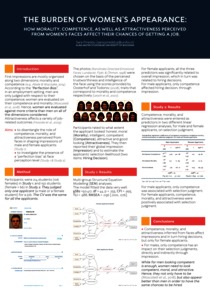Pireddu, Sara
(2018)
The burden of women.
In: XV Convegno Nazionale della Sezione di Psicologia Sociale dell’AIP, 19-21 settembre 2018, Bari.
Full text disponibile come:
![[thumbnail of Poster presentation]](https://amsacta.unibo.it/6439/1.hassmallThumbnailVersion/Poster_THE%20BURDEN%20OF%20WOMEN.pdf)  Anteprima |
Documento di testo(pdf) (Poster presentation)
Licenza: Salvo eventuali più ampie autorizzazioni dell'autore, il contributo può essere liberamente consultato e può essere effettuato il salvataggio e la stampa di una copia per fini strettamente personali di studio, di ricerca e di insegnamento, con espresso divieto di qualunque utilizzo direttamente o indirettamente commerciale. Ogni altro diritto sul materiale è riservato.
Download (3MB)
| Anteprima
|
Abstract
We investigated whether morality, competence, and attractiveness perceived from applicants’ faces affect their likelihood of being hired and whether these effects vary as a function of their gender. In two studies, participants were provided with a photo of a female or a male applicant attached to a brief CV. Applicants’ faces (Lundqvist et al., 1998) differed in the level of perceived trustworthiness and intelligence (Oosterof & Todorov, 2008), which are traits related to morality and competence respectively (Leach et al., 2007). In Study 1, respondents were asked to evaluate applicants on morality, competence, attractiveness, and to rate their likelihood of selection. Two moderated mediation analyses revealed that attractiveness mediated the effect of both morality and competence on selection decisions, but this was true only for female applicants. In Study 2, participants were instructed to rate the extent to which each applicant would behave in a competent and moral manner in his/her work, as well as his/her attractiveness and selection likelihood. While only competence had an impact on male applicants’ likelihood of being selected, hiring decisions about females were based on morality, competence, as well as attractiveness. Overall, these findings highlighted that women not only have to be (Moscatelli et al., 2018), but also to appear better than men on multiple judgment dimensions to be hired.
Abstract
We investigated whether morality, competence, and attractiveness perceived from applicants’ faces affect their likelihood of being hired and whether these effects vary as a function of their gender. In two studies, participants were provided with a photo of a female or a male applicant attached to a brief CV. Applicants’ faces (Lundqvist et al., 1998) differed in the level of perceived trustworthiness and intelligence (Oosterof & Todorov, 2008), which are traits related to morality and competence respectively (Leach et al., 2007). In Study 1, respondents were asked to evaluate applicants on morality, competence, attractiveness, and to rate their likelihood of selection. Two moderated mediation analyses revealed that attractiveness mediated the effect of both morality and competence on selection decisions, but this was true only for female applicants. In Study 2, participants were instructed to rate the extent to which each applicant would behave in a competent and moral manner in his/her work, as well as his/her attractiveness and selection likelihood. While only competence had an impact on male applicants’ likelihood of being selected, hiring decisions about females were based on morality, competence, as well as attractiveness. Overall, these findings highlighted that women not only have to be (Moscatelli et al., 2018), but also to appear better than men on multiple judgment dimensions to be hired.
Tipologia del documento
Documento relativo ad un convegno o altro evento
(Poster)
Autori
Settori scientifico-disciplinari
DOI
Data di deposito
23 Lug 2020 10:46
Ultima modifica
01 Gen 2023 22:00
URI
Altri metadati
Tipologia del documento
Documento relativo ad un convegno o altro evento
(Poster)
Autori
Settori scientifico-disciplinari
DOI
Data di deposito
23 Lug 2020 10:46
Ultima modifica
01 Gen 2023 22:00
URI
Statistica sui download
Statistica sui download
Gestione del documento:



 Login per gli autori
Login per gli autori



